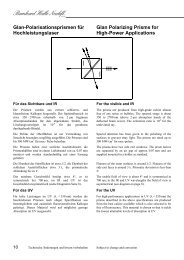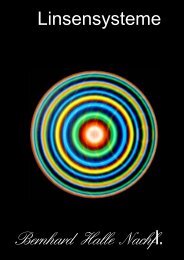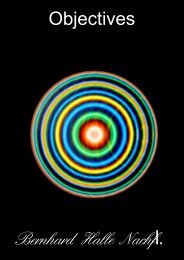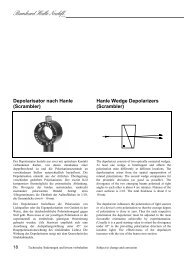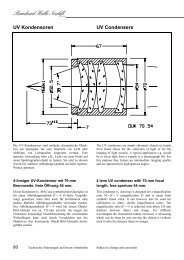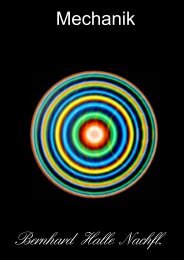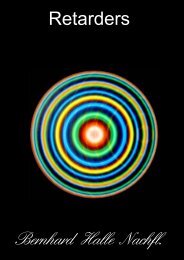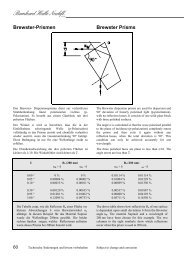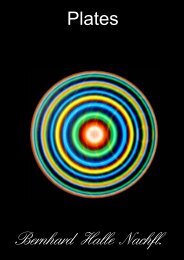Wollaston- und Rochon - Bernhard Halle
Wollaston- und Rochon - Bernhard Halle
Wollaston- und Rochon - Bernhard Halle
Sie wollen auch ein ePaper? Erhöhen Sie die Reichweite Ihrer Titel.
YUMPU macht aus Druck-PDFs automatisch weboptimierte ePaper, die Google liebt.
<strong>Bernhard</strong> <strong>Halle</strong> Nachfl.<br />
GmbH<br />
Verzögerungsplatten aus MgF2:<br />
low-order<br />
Die Verzögerer bestehen aus einer Einzelplatte mit einer<br />
Dicke von 0,15 mm bis 0,5 mm. Die allgemeinen<br />
Eigenschaften <strong>und</strong> das Funktionsprinzip sind identisch mit<br />
denen der low-order-Platten aus Quarzkristall (Seite 22).<br />
Der wesentliche Unterschied zu Quarzkristall besteht im<br />
Transmissionsbereich von MgF2 der etwa von 120 nm bis<br />
7 µm reicht. In einigen Fällen ist auch die bei MgF2 im<br />
Gegensatz zu Quarz nicht vorhandene optische Aktivität<br />
vorteilhaft, welche bei sehr hohen Anforderungen an die<br />
Polarisation störend wirken kann.<br />
Die Wellenfrontdeformation beträgt λ/10 (bei λ = 550 nm)<br />
<strong>und</strong> der Keilfehler ist kleiner als 2’’. Die Genauigkeit des<br />
Gangunterschieds beträgt ±3 nm.<br />
Die nutzbare spektrale Breite für eine einzelne Platte ist im<br />
sichtbaren <strong>und</strong> ultravioletten Spektralbereich ähnlich wie<br />
die der low-order-Verögerungsplatten aus Quarz. Für<br />
Wellenlängen oberhalb von 3,5 µm können aber<br />
Einzelplatten mit Ordnungszahl null gefertigt werden. Für<br />
diese gilt dann die Abschätzung wie für zweiteilige zeroorder-Platten.<br />
Eine Abschätzung der Abweichung ∆R vom Sollwert R der<br />
Verzögerung (jeweils in nm) aufgr<strong>und</strong> von<br />
Temperaturänderung um ∆T (in K) oder Neigung um ∆φ<br />
(in Grad) ist wie folgt möglich:<br />
∆R ≈ -(0,1 nm/K)·∆T<br />
∆R ≈ ±(0,2 nm/Grad²)·∆φ²<br />
Die Abweichungen für Temperaturänderungen bis zu<br />
±30 K oder Kippwinkel bis zu ±4° liegen unterhalb der<br />
Fertigungstoleranz.<br />
Die Platten werden ohne Entspiegelung in einer<br />
Zylinderfassung aus eloxiertem Aluminium mit Gravur der<br />
schnellen Achse, des Gangunterschiedes <strong>und</strong> der<br />
Wellenlänge geliefert.<br />
MgF2 Retarders: low order<br />
The retarders are single plates with a thickness of 0.15 mm<br />
to 0.5 mm. The general properties and the working<br />
principle are identical with those of the low order retarders<br />
made of quartz crystal (page 22). The main difference is the<br />
broader spectral transmission of MgF2 which reaches from<br />
approx. 120 nm to 7 µm. In some cases the lack of optical<br />
activity in MgF2 is of advantage, as its presence in quartz<br />
crystal may be disturbing in applications where an<br />
extremely high degree of polarisation is of concern.<br />
The wavefront distortion is λ/10 (at λ = 550 nm) and the<br />
wedge error is smaller than 2’’. The accuracy of the path<br />
difference is ± 3 nm.<br />
The useable spectral width for a single plate in the visible<br />
and ultraviolet spectral range is similar to that of quartz low<br />
order plates. For wavelengths above 3.5 µm single plates<br />
can be manufactured with an order number of zero. In this<br />
case the estimation of the spectral width is identical as in<br />
the case of two part zero order plates.<br />
The deviation ∆R of the path difference from the nominal<br />
value R (both in nm) due to a temperature change by ∆T (in<br />
K) or due to tilt by ∆φ (in degrees) can be estimated as<br />
follows:<br />
∆R ≈ -(0.1 nm/K)·∆T<br />
∆R ≈ ±(0.2 nm/deg²)·∆φ²<br />
The deviations will be smaller than the production tolerance<br />
for temperature changes up to ±30 K or for a tilt up to ±4°.<br />
The plates are delivered without AR coating mounted in a<br />
cylindrical holder made of anodized aluminum and engraved<br />
with the direction of the fast axis, the path difference and the<br />
design wavelength.<br />
Öffnung/Aperture Fassung/Holder<br />
Durchmesser/diameter Durchmesser/diameter Länge/length λ/2 λ/4<br />
9.5 mm 25 mm 10 mm RLM 2.10 RLM 4.10<br />
14.5 mm 25 mm 10 mm RLM 2.15 RLM 4.15<br />
19.5 mm 30 mm 15 mm RLM 2.20 RLM 4.20<br />
24.5 mm 40 mm 15 mm RLM 2.25 RLM 4.25<br />
Wichtig: Important note:<br />
Bei Bestellung bitte die gewünschte Wellenlänge angeben. Please specify required wavelength when ordering.<br />
Die Listenpreise gelten für Standardwellenlängen gemäß<br />
folgender Tabelle.<br />
The prices apply to standard wavelengths according to the<br />
following table.<br />
26 Technische Änderungen <strong>und</strong> Irrtum vorbehalten Subject to change and correction



